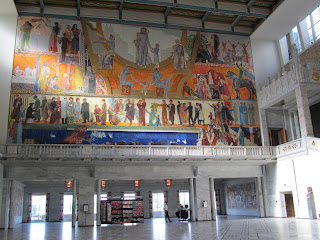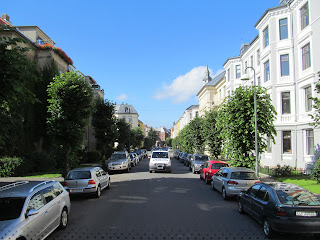Oslo City Hall Great Room where Nobel Peace Prize is awarded
Oslo City Hall Mural (portion)
Oslo City Hall
Oslo City Hall Harbor View
We strolled through Frogner Park with sculptor Gustav Vigeland’s over 200 extraordinary bronze and concrete sculptures. Vigeland was contracted to prepare and place sculptures in the park and he worked at this task for 40 years until he died. He did all the decorative artwork in the park, including the gates, and it is truly an amazing place. His work ranged from entwined lovers to thoughtful and calm elderly couples to a hotheaded boy caught in a bad mood--all of which are nude.
Frogner Park
We drove through numerous neighborhoods, several of which had buildings containing condominiums, which we were told, sell for $1 to $3 million USD. Home ownership is important in Norway and we were told 80% of Norwegians own their homes. Homes in Norway are expensive, and with average take-home pay approaching $40,000 USD per worker, I never did completely figure out how they afford to own their homes. Most women work outside the home so a couple would likely have around $80,000 USD after taxes. The government has generous tax incentives for home ownership and interest rates are about the same as in the U.S. In addition, their health care and education through college are paid through their tax system.
$1-3 million USD condos
Oslo has to deal with street people, particularly from Romania, for the first time. We were told that Eastern Europeans and Russians are leaving their countries in large numbers and traveling to cities in western and northern Europe. In Oslo, the immigrants do not have jobs and crime rates involving them are rising quite rapidly. We were warned about several areas to avoid around the downtown area if we decided to go exploring from the hotel.
We visited three museums featuring Norway’s long seafaring tradition in the afternoon. The Viking Ship Museum with its ships and artifacts from the Viking era on display was particularly interesting to me. Viking nobility was buried in their boats when they died along with possessions and everything that it was believed would be needed in the hereafter, including items such as jewels, furniture, servants, food, intricately carved carriages and sleighs, tapestries, etc. The sleek dark longboats on display are the best preserved that have been found and are quite large. In the case of one boat on display that belonged to a queen, the queen’s maid was killed and buried next to her. All three boats in the museum were made of oak in the 9th century and were buried about the same time. The boats had been buried in clay on beaches in the Oslofjord region and the clay served to hermetically seal and preserve the boats and their contents. The boats and contents on display were very interesting to examine and provided insight into the Viking traditions and culture.


Viking Long Boat
Carriage found in Long Boat
We next visited the Polarship Fram Museum that featured the ship of the same name. The ship was launched in 1892 and was the strongest one afloat at the time. It carried several polar explorers, including Fridtjof Nansen, Roald Amundsen, and Otto Sverdrup on journeys to the North and South Pole regions as well as on other polar explorations. We were able to explore the ship fully and the museum had excellent exhibits on polar exploration.
Fram Polarship
The final museum we visited was the Kon-Tiki Museum featuring Thor Heyerdahl’s “Kon-Tiki”, a balsa raft that he sailed from Peru to Polynesia in 1947. A reed boat, the “Ra II” used by Heyerdahl to cross the Atlantic Ocean in 1970 is also on display. The success of both trips in these boats seems even more amazing after looking at the boats! However, Heyerdahl was able to show that people could travel long distances on water long ago.
"RA II"
"Kon-Tiki"
This concluded our fast tour of central and southern Norway. The area really is a land of contrasts and immense beauty!
Fast Facts: The Viking era lasted about 250 years from approximately 790 to 1040. Vikings traveled widely to the Black Sea, throughout the Mediterranean, and to the British Isles, Iceland, Greenland, and the North American continent. Although they were famous for plundering lands abroad, the fruit of their fighting served to raise the standard of living at home. The Vikings are credited with bringing Christianity to their Homeland, which resulted in the demise of their way of living.
North Sea Oil profits have helped transform Norway from one of Europe’s poorest nations to one of Europe’s wealthiest nations.
SUNDAY, AUGUST 5, 2012
After a fast-paced two weeks (yes, it was two weeks ago today that I left Sioux Falls), I felt the need to slow down some today. I took a walk around the downtown area after breakfast and picked up another geocache in the process--my last in Norway. I also checked out the train station to get a feel for where to go in the morning when I get ready to leave. The station is less than a block from the hotel (Clarion Hotel Royal Christiania) so is very convenient. The rest of the day was spent working on the blog, repacking the bags, reading and relaxing. It felt good not to be on a schedule!
| 
















